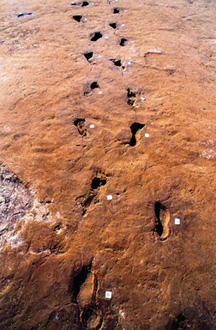Geotimes

Untitled Document

News Notes
Volcanoes
Fleeing Vesuvius
A picture is worth more than a thousand words in the case of what some newly
uncovered footprints in Vesuvian ash (see photo below) are telling researchers
about the hazards that Italy’s most notorious volcano might pose in the
future.
 One to 2 meters below volcanic deposits
from the A.D. 79 eruption that buried the slopeside cities of Pompeii and Herculaneum,
a team of volcanologists and archaeologists found thick volcanic deposits dating
to around 3,780 radiocarbon years before present. The evidence thus supports
that Vesuvius erupted in a far more devastating event around 2000 B.C. than
it had in its most famous A.D. 79 eruption, says Michael Sheridan, a volcanologist
at the University at Buffalo in New York, and co-author on a report in the March
6 Proceedings of the National Academy of Sciences.
One to 2 meters below volcanic deposits
from the A.D. 79 eruption that buried the slopeside cities of Pompeii and Herculaneum,
a team of volcanologists and archaeologists found thick volcanic deposits dating
to around 3,780 radiocarbon years before present. The evidence thus supports
that Vesuvius erupted in a far more devastating event around 2000 B.C. than
it had in its most famous A.D. 79 eruption, says Michael Sheridan, a volcanologist
at the University at Buffalo in New York, and co-author on a report in the March
6 Proceedings of the National Academy of Sciences.
In this Bronze Age eruption, at least six distinct destructive surges produced
4 cubic kilometers of pumice and ash that rose in a plume some 36 kilometers
(22 miles) high, according to modeling, Sheridan says. The research team, led
by Italian volcanologist Giuseppe Mastrolorenzo, found continuous ash beds from
tens of centimeters to 15 meters thick from this event, extending to the northwest
from Vesuvius.
Image is courtesy of PNAS.
Models of the event indicate that total devastation would have occurred as
far as 12 kilometers away, reaching well into present-day Naples. Floods, mudflows
and ash fall affected people as far as 70 kilometers from the volcano, Sheridan
says.
Fortunately, the researchers wrote, it appears that most inhabitants of the
region likely got out safely: Thousands of footprints of adults, children and
animals heading northward away from the volcano embedded in layers of ash suggest
that there was a sudden mass exodus from the area.
The destruction that occurred from the Bronze Age eruption also portends warnings
for the 3 million residents in modern-day Naples and the surrounding cities
in Vesuvius’ shadow, Sheridan says. Because an event of this scale is capable
of devastating a wide territory that includes Naples, he says, emergency management
and evacuation plans should consider this event as reference for a worst-case
scenario eruption at Vesuvius.
Megan Sever
Links:
"Italy's hidden hazard," Geotimes, April 2006
Print
Exclusive
"Vesuvius' next eruption,"
Geotimes, April 2005
Back to top
Untitled Document

 One to 2 meters below volcanic deposits
from the A.D. 79 eruption that buried the slopeside cities of Pompeii and Herculaneum,
a team of volcanologists and archaeologists found thick volcanic deposits dating
to around 3,780 radiocarbon years before present. The evidence thus supports
that Vesuvius erupted in a far more devastating event around 2000 B.C. than
it had in its most famous A.D. 79 eruption, says Michael Sheridan, a volcanologist
at the University at Buffalo in New York, and co-author on a report in the March
6 Proceedings of the National Academy of Sciences.
One to 2 meters below volcanic deposits
from the A.D. 79 eruption that buried the slopeside cities of Pompeii and Herculaneum,
a team of volcanologists and archaeologists found thick volcanic deposits dating
to around 3,780 radiocarbon years before present. The evidence thus supports
that Vesuvius erupted in a far more devastating event around 2000 B.C. than
it had in its most famous A.D. 79 eruption, says Michael Sheridan, a volcanologist
at the University at Buffalo in New York, and co-author on a report in the March
6 Proceedings of the National Academy of Sciences.
